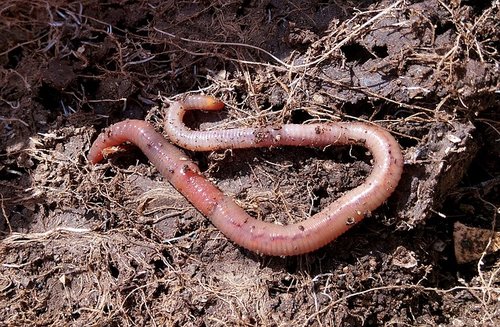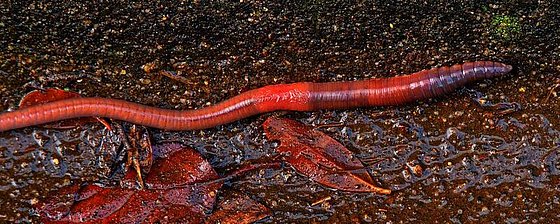
Earthworms - clever soil improvers
Prof Dr Gela Preisfeld / Biology
Photo: Sebastian Jarych
The clever soil improver
Biologist Gela Preisfeld on the fascinating organism of the earthworm
Even the ancient Egyptians and Greeks were aware of their importance and canonised them. Aristotle reverently referred to them as the 'bowels of the earth' and Charles Darwin even dedicated his last book to them: Earthworms. In relation to their body size, they can easily be described as the strongest animals on earth. Their organisms are fascinating and Wuppertal biologist Gela Preisfeld has some fascinating stories to tell about them.
The lively worm and its family of the little borers
Although many people think that the earthworm is called an earthworm because it comes to the surface when it rains, Preisfeld says that as early as the 16th century it was generally referred to as the 'lively worm' because it eats and digs tirelessly. Around 40 different earthworms live in our latitudes and almost 700 worldwide. "When we say earthworms, we mean the animals that we generally know," explains the biologist, "and these are the dewworm(Lumbricus terrestris) and the slightly lighter-coloured compost worm(Eisenia fetida)." Up to 3000 similar worms can be found in the literature, says Preisfeld, but close relatives have also been counted. "Earthworms belong to the annelids, the annelids." And you can understand this very well when you look at an earthworm. "It has lots of rings, like little chain links (segments) that are connected in series. Within these annelids there are two large groups, the many-borers and the few-borers. And the earthworm belongs to the few-borers." Such a worm can usually live for two years, but specimens of seven and eight years old have also been found that have not fallen victim to birds, moles or the bright UV light.
Graceful physique and harmonious locomotor system
The fascinating body structure of the earthworm consists of many segments that are connected in series. "Each segment has the same basic structure and is formed at the rear end of the worm. The head part is the oldest and the worm grows by constantly forming new segments from the back," explains the biologist. These then later differentiate into the digestive organs, heart, etc. in the front part of the worm. Each segment also has four bristles, which are firmly anchored in the muscles and which the worm uses like spikes to hold on. "If you let an earthworm run over paper and listen, you can really hear it rustle." Following its ring-shaped stature, the legless worm moves through muscle contractions. "It has ring muscles all the way through its body. Each segment can contract, making the worm thinner and longer. At the same time, it has longitudinal muscles which, when contracted, make the worm shorter and thicker." If the ring muscles contract at the front, the worm pushes itself forwards, while the longitudinal muscles shorten at the end and push the rear end backwards. Its body is also able to regenerate entire segments. "If it is severed at the rear and the vital organs remain intact, the rear end can regenerate and grow back if no infections occur," adds Preisfeld. The severed rear end dies, as the brain and mouth opening cannot be regenerated.

Earthworm
Photo: public domain
The sexual luxury of hermaphrodites
The sexual life of earthworms can be described as both exciting and bizarre, because earthworms are hermaphrodites. "They have both sexes. Every earthworm has male and female genital openings and each worm fertilises its partner during mating," explains the scientist, which is very exciting. Like many other dual-sex animals, they do not usually fertilise themselves, but prefer to have sex in pairs. In doing so, they behave in a mannerly and almost tender way. "Earthworms belong to the so-called clitellata, i.e. they have a clitellum, a belt around part of their epidermis," explains Preisfeld.
If you take a closer look at an earthworm, you can see the lighter-coloured, thickened structure of the clitellum in its front third. In this area, the epidermis, the outer layer of skin, is equipped with many glands. "During reproduction, two earthworms come out of the soil with their front ends and lie against each other so that the girdle of one is opposite the sperm pocket of the other. This clitellum then secretes mucus to bind the bodies together. The sperm are released and a sperm channel forms between the animals from both sides. The sperm then flows from earthworm one into the sperm pocket of the partner. This happens in both directions." In addition, the belt now releases additional mucus, which hardens and pushes towards the heads of both worms, thus combining the released eggs and sperm into a cocoon, which the worm finally releases into the soil through contraction. "Fertilisation then takes place in this cocoon. After around 90 days for the dew worm and 16 days for the compost worm, the little worms hatch."
Filigree nervous system
The earthworm's nervous system is very delicate, and although it has no eyes, it is still sensitive to light. "The nervous system of earthworms is structured like a rope ladder," explains the expert. "There are two nerve cords on the ventral side that run through all segments of the worm. In each segment, these longitudinal nerve cords are connected by cross-connections, like rungs. They provide the contact between the pair of nerve cell bodies, so-called ganglia, which also occur in each segment, and the longitudinal nerve cords. These are connected in the head area to the cerebral ganglion, a simple brain, and can therefore send information to every region of the body." Although earthworms do not have sensory organs like humans, they do have sensory cells with photoreceptors, which are located in the head area in particular. "There are not only a lot of light-sensing cells in the skin, which can then perceive light and dark and pass on information, but also other receptors that measure the pH value, for example, because the animals cannot tolerate soil that is too acidic." The earthworm has giant nerve cells with a very large diameter, which enables it to transmit impulses very quickly and then retreat quickly in the event of danger.
Microorganisms, fungi and a long digestive pathway
The lively worm is mostly nocturnal and also utilises the help of microorganisms and fungi to feed. "This shows that they are not unintelligent animals at all. Earthworms are capable of learning, they can even avoid an electric shock," says Preisfeld. "They get the leaves into their living tubes and store them there first by sticking them to the walls with their mucus. Then the microorganisms and fungi come into play, in a similar way to leaf-cutting ants. The worm can then ingest the pre-rotted plants and digest them further." And the worm's digestive path is particularly long. "This is always the case with organisms that feed on plants. When it ingests the food, it is first moistened in the mouth. Then the gullet sucks the food back a little, presses it down and pushes it into the stomach through muscle contractions. There is also sand in the stomach, as the worm has no teeth and cannot chew, so the stomach always contracts and grinds the plants with the sand. The animal's digestive system contains bacteria and other microorganisms, and the food is digested there with their help. Their intestines have a so-called typhlosolis, which are invaginations of the intestinal wall, so that the surface area increases, similar to our intestinal villi. There is then more surface area and more can be digested."

Earthworm on the road
Picture: Pixabay
Escape behaviour in pattering rain
Earthworms always come to the surface when it rains, even though daylight often has fatal consequences. The scientist explains that it has nothing to do with the fact that worms drown in the water, as they are also able to filter oxygen out of the water via their soft epidermis. "If you see them on the wet road, they can't survive there for long because UV light is lethal to them. They have no UV protection." Scientists now suspect two other reasons for the upward flight. "On the one hand, oxygen is easier to absorb through the air than through the water and they also flee upwards because the raindrop sounds are similar to the vibrations of a burrowing mole. It is then a protective reaction."
The wallpaper of the soil improver
A French farmer's saying goes: 'The good Lord knows how to make fertile soil, and he has entrusted his secret to earthworms. `
When earthworms bore their tubes into the soil, experts refer to this as 'wallpaper'. "This is the lining of the worm tube, so to speak," explains Preisfeld, "the worm is constantly excreting a little mucus and faeces and there are also many microorganisms, bacteria and fungi in there. They line the wall of the tube, so to speak. This creates an absorbent inner structure, which is known as wallpaper." The role of the earthworm in the ecosystem is invaluable. Around 100 earthworms can be found in one cubic metre of normal garden soil, explains the researcher, but 1000 worms have also been found in well-aerated soil. "In such a cubic metre, the animals manage to build around 20 metres of tunnels and can also go deep. Worms have been found at a depth of seven metres if the soil is permeable. We say that earthworms are soil improvers, and that's true. So when they build their tubes and pull the leaves and organic substances into them, they definitely manage to distribute the nutrients in the soil. They ensure that minerals also reach deeper areas of the soil and aerate the soil through their tunnels. The wallpaper acts like a sponge, so it can actually absorb moisture and thus moisten the soil."
Such a soil can absorb a downpour very well. Good, clean humus is formed from the faeces and the excreted humus, which forms complexes with clay from the soil.
complexes that can bind nutrients. As a result, the nutrients remain in the root area of the plants as if in a depot, making it easier for the roots to absorb the minerals.
Preisfeld knows that these creatures can even cope with strong temperature fluctuations. "They are fascinating because even if the weather conditions are not ideal, they curl up and can survive the colder temperatures better. That's how we find them in the soil in early spring. They completely switch off their metabolism and become active again when it gets warmer."
Uwe Blass
Professor Dr Gela Preisfeld studied, obtained her doctorate and habilitated at Bielefeld University. After short research stays in Australia and a temporary position at the Goethe University in Frankfurt/Main, she accepted a professorship in Biology and its Didactics, Zoology at the University of Wuppertal in 2006.
